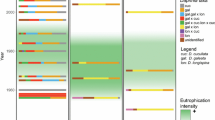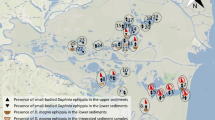Abstract
Allozyme diversity of a population of D. pulex was studied over two seasons in a small lake (Gräfenhain, Saxony, Germany). In this eutrophic lake, accumulation of hydrogen sulfide during winter ice covers leads to an annual killing-off of cladocerans. Hence, the population must be re-established every year by hatchlings from sexual eggs. The absence of planktivorous fish due to strong biomanipulation ensures high abundances of Daphnia from June until September. Besides the investigation of seasonal changes of genotype diversity, vertical differences between individuals from the epilimnion and from a deep chlorophyll maximum (DCM) were studied. Specimens were classified by allozyme electrophoresis using six allozyme loci. Except for aldehyde oxidase (AO) all tested allozyme loci were monomorphic. Two alleles were found at the AO-locus in the overall study, allowing the population to be subdivided into three clonegroups (ss, fs, ff). The proportion of each clonegroup both in the epilimnion and in the DCM did not vary over the two seasons and no differences were found in the year-to-year comparison. Although two completely different habitats (epilimnion, DCM) were found to be used by D. pulex, clonal structure in both depth strata was similar at all times indicating no intraspecific segregation of the population. In spite of a non-permanent population with periodical sexual reproduction, a constant deviation from Hardy-Weinberg-equilibrium was detected in the overall study. This remarkable genetic structure is interpreted to be the result of both founder effects and a strong and long-lasting selection pressure caused by 15 years of stationary conditions due to intense biomanipulation.
Similar content being viewed by others
References
Bachiorri, A., V. Rossi & P. Menozi, 1991. Enzymatic variability of a colonizing population of Daphnia obtusa Kurz (Crustacea, Cladocera). Verh. int. Ver. Limnol. 24: 2813-2815.
Benndorf, J., H. Kneschke, K. Kossatz & E. Penz, 1984. Manipulation of the pelagic food web by stocking with predaceous shes. Internationale Revue Der Gesamten Hydrobiologie 69: 407-428.
Benndorf, J., B. Wissel, A. F. Sell, U. Hornig, P. Ritter & W. Bö ing, 2000. Food web manipulation by extreme enhancement of piscivory: an invertaberate predator compensates for the effects of planktivorous sh on a plankton community. Limnologica 30: 235-245.
Cerny, M. & P. D. N. Hebert, 1999. Intercontinental allozyme differentiation among four holarctic Daphnia species. Limnology and Oceanography 44: 1381-1387.
Crease, T. J., S. K. Lee, S. L. Yu, K. Spitze, N. Lehman & M. Lynch, 1997. Allozyme and mtDNA variation in populations of the Daphnia pulex complex from both sides of the Rocky Mountains. Heredity 79: 242-251.
Davison, J., 1969. Activation of the ephippial eggs of Daphnia pulex. Journal of Genetic Physiology 53: 565-575.
De Meester, L., 1996. Local genetic differentiation and adaptation in freshwater zooplankton populations: patterns and processes. Ecoscience 3: 385-399.
De Meester, L. & L. J. Weider, 1999. Depth selection behavior, sh kairomones, and the life histories of Daphnia hyalina X galeata hybrid clones. Limnology and Oceanography 44: 1248-1258.
Epp, G. T., 1996. Clonal variation in the survival and reproduction of Daphnia pulicaria under low-food stress. Freshwater Biology 35: 1-10.
Flöβ ner, D., 2000. Die Haplopoda und Cladocera Mitteleuropas. Backhuys Publishers, Leiden, p. 428.
Haney, J. F. & D. J. Hall, 1975. Sugar coated Daphnia: A preservation technique for Cladocera. Limnology and Oceanography 18: 331-333.
Hebert, P. D. N., 1987. Genetics of Daphnia. In Peters, R. H. & R. de Bernardi (eds), Daphnia. Istituto Italiano di Idrobiologia, Pallanza: 439-460.
Hebert, P. D. N. & M. J. Beaton, 1989. Methodologies for allozyme analysis using cellulose acetate electrophoresis. Helena Laboratories, Beaumont, Texas, p. 32.
Hebert, P. D. N., S. S. Schwartz & J. Hrbacek, 1989. Patterns of genotypic diversity in Czechoslovakian Daphnia. Heredity 62: 207-216.
Herbert, M. R., 1954. The tolerance of oxygen deficiency in the water by certain cladocera. Memorie dell 'Istituto Italiano di Idrobiologia 9: 97-107.
Hobaek, A. & P. Larsson, 1990. Sex determination in Daphnia magna. Ecology 71: 2255-2268.
Hoffmann, A. A., 1995. Ecological population genetics: the interface between genes and the environment. Annual Review of Genetics 29: 349-370.
Jacobs, J., 1990. Microevolution in predominantly clonal populations of pelagic Daphnia (Crustacea, Phyllopoda) — selection, exchange and sex. Journal of Evolutionary Biology 3: 257-282.
King, C. E. & M. R. Miracle, 1995. Diel vertical migration by Daphnia longispina in a Spanish lake — genetic sources of distributional variation. Limnology and Oceanography 40: 226-231.
Knisely, K. & W. Geller, 1986. Selective feeding of four zooplankton species on natural lake phytoplankton. Oecologia 69: 86-94.
Lynch, M., 1984. The genetic structure of a cyclical parthenogen. Evolution 38: 186-203.
Lynch, M., 1985. Speciation in the Cladocera. Verh. int. Ver. Limnol. 22: 3116-3123.
Mort, M. A. & H. G. Wolf, 1986. The genetic structure of large — lake Daphnia populations. Evolution 40: 756-766.
Pfrender, M. E. & M. Lynch, 2000. Quantitative genetic variation in Daphnia: temporal changes in genetic architecture. Evolution 54: 1502-1509.
Salonen, K. & A. Lehtovaara, 1992. Migrations of hemoglobin-rich Daphnia longispina in a small, steeply stratified, humic lake with an anoxic hypolimnion. Hydrobiologia 229: 271-288.
Sell, A. F., U. Hornig & J. Benndorf, 1997. Long-term effects of planktivore removal: results from a manipulated and a reference lake. Verh. int. Ver. Limnol. 26: 782-785.
Stross, R. G., 1965. Termination of summer and winter diapause in Daphnia. American Journal of Zoology 5: 701-757.
Stross, R. G., 1987. Photoperiodism and phased growth in Daphnia populations: coactions in perspective. In Peters, R.H. & R. De Bernardi (eds), Daphnia. Istituto Italiano di Idrobiologia, Pallanza: 413-437.
Weider, L. J., 1984. Spatial heterogeneity of Daphnia genotypes — vertical migration and habitat partitioning. Limnology and Oceanography 29: 225-235.
Weider, L. J. & A. Hobaek, 2003. Glacial refugia, haplotype distributions and clonal richness of the Daphnia pulex complex in arctic Canada. Molecular Ecology 12: 463-473.
Weider, L. J., A. Hobaek, P. D. N. Hebert & T. J. Crease, 1999. Holarctic phylogeography of an asexual species complex — II. Allozymic variation and clonal structure in Arctic Daphnia. Molecular Ecology 8: 1-13.
Weider, L. J. & W. Lampert, 1985. Differential response of Daphnia genotypes to oxygen stress: respiration rates, hemoglobin content and low-oxygen tolerance. Oecologia 65: 487-491.
Weider, L. J. & H. B. Stich, 1992. Spatial and temporal heterogenity of Daphnia in Lake Constance; intra-and interspecific comparisons. Limnology and Oceanography 37: 1327-1334.
Wissel, B., K. Freier, B. MÜ ller, J. H. E. Koop & J. Benndorf, 2000. Moderate planktivorous sh biomass stabilizes biomanipulation by suppressing large invertebrate preadators of Daphnia. Archives of Hydrobiology 149: 177-192.
Wolf, H. G. & G. R. Carvalho, 1989. Resting eggs of lake-Daphnia. II. In situ observations on the hatching of eggs and their contribution to population and community structure. Freshwater Biology 22: 471-478.
Author information
Authors and Affiliations
Rights and permissions
About this article
Cite this article
Matthes, M. Low Genotypic Diversity in a Daphnia Pulex Population in a Biomanipulated Lake: The Lack of Vertical and Seasonal Variability. Hydrobiologia 526, 33–42 (2004). https://doi.org/10.1023/B:HYDR.0000041616.86446.01
Issue Date:
DOI: https://doi.org/10.1023/B:HYDR.0000041616.86446.01




